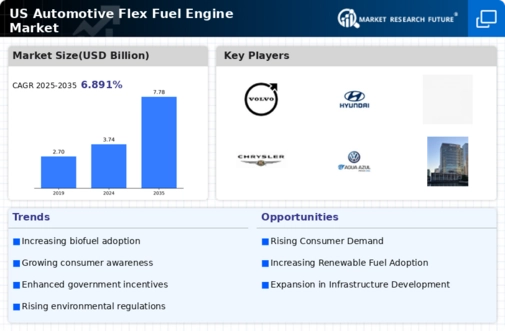Rising Fuel Prices
The automotive flex-fuel-engine market is experiencing a notable impact from rising fuel prices, which have prompted consumers to seek more economical alternatives. As gasoline prices fluctuate, the cost-effectiveness of flex-fuel vehicles becomes increasingly attractive. Flex-fuel engines can operate on a variety of fuels, including ethanol, which is often less expensive than traditional gasoline. According to recent data, the average price of E85 (a common ethanol blend) is approximately 20% lower than regular gasoline. This price differential encourages consumers to consider flex-fuel vehicles as a viable option, thereby driving growth in the automotive flex-fuel-engine market. The potential for savings at the pump is a compelling factor for many buyers, influencing their purchasing decisions.
Environmental Regulations
Stringent environmental regulations are a significant driver for the automotive flex-fuel-engine market. The U.S. government has established various emissions standards aimed at reducing greenhouse gas emissions from vehicles. These regulations often necessitate the adoption of cleaner technologies, including flex-fuel engines that can utilize renewable fuels like ethanol. The Environmental Protection Agency (EPA) has set ambitious targets for reducing emissions, which has led manufacturers to invest in flex-fuel technology. As a result, the automotive flex-fuel-engine market is likely to expand as automakers respond to regulatory pressures by increasing the production of compliant vehicles. This trend not only aligns with environmental goals but also enhances the market's attractiveness to eco-conscious consumers.
Consumer Awareness and Education
Increasing consumer awareness regarding the benefits of flex-fuel vehicles is driving growth in the automotive flex-fuel-engine market. Educational campaigns by manufacturers and environmental organizations have highlighted the advantages of using renewable fuels, such as reduced carbon emissions and lower dependency on fossil fuels. As consumers become more informed about the environmental and economic benefits of flex-fuel vehicles, their willingness to purchase these cars increases. Surveys indicate that nearly 60% of potential car buyers express interest in vehicles that can run on alternative fuels. This growing awareness is likely to lead to a higher market penetration of flex-fuel vehicles, as consumers actively seek out options that align with their values.
Government Incentives for Alternative Fuels
The automotive flex-fuel-engine market benefits from various government incentives aimed at promoting alternative fuel vehicles. Federal and state programs often provide tax credits, rebates, and grants to consumers and manufacturers. For instance, the federal tax credit for flex-fuel vehicles can reach up to $7,500, encouraging consumers to opt for these vehicles. Additionally, states like California and Texas have implemented their own incentives, further stimulating market growth. These financial benefits not only lower the initial purchase cost but also enhance the overall appeal of flex-fuel vehicles. As a result, the automotive flex-fuel-engine market is likely to see increased adoption rates, driven by these supportive policies that align with broader environmental goals.
Technological Innovations in Fuel Production
Advancements in fuel production technology are playing a crucial role in shaping the automotive flex-fuel-engine market. Innovations in the production of biofuels, particularly ethanol, have made these fuels more accessible and cost-effective. For instance, the development of cellulosic ethanol, derived from non-food biomass, has the potential to significantly increase the supply of renewable fuel. This not only supports the automotive flex-fuel-engine market by providing a sustainable fuel source but also addresses concerns regarding food supply and fuel competition. As production technologies continue to evolve, the availability and affordability of flex-fuel options are expected to improve, further driving consumer adoption and market growth.





















Leave a Comment